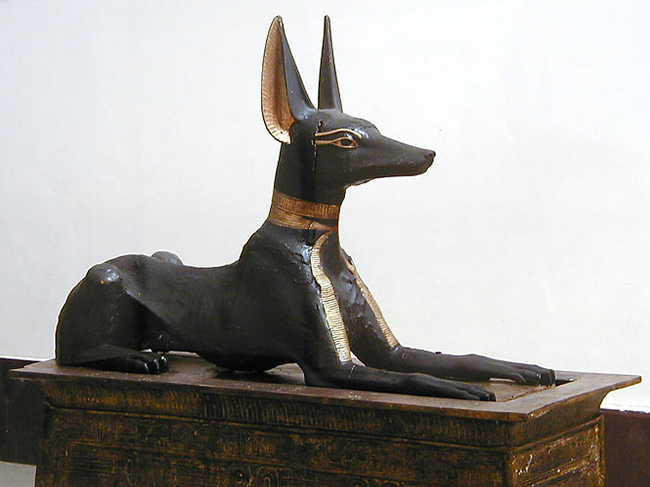Anubis: Guide of the Afterlife
Breaking the silence of the Luxor desert, amidst the Theban necropolis, stands a mysterious guardian—the statue of the jackal-headed god Anubis. Carved from stone by ancient Egyptian artisans thousands of years ago, this figure is not merely a sculpture but an eternal sentinel positioned between the realms of the living and the dead.
The statue rests on a rectangular base, its back leaning in a vigilant stance. With erect ears, sharp eyes, and the solidity of stone, it inspires awe, reverence, and a sense of fear. When the desert sun strikes its polished surface, it seems as though the god himself is radiating an eternal warning—that none may escape the laws of the afterlife.
Anubis: Protector of Death and the Afterlife
In Egyptian mythology, Anubis (Egyptian name: Inpu or Anpu) was the god of mummification and tombs. He was imagined either as a black jackal or a man with a jackal’s head. The choice of the jackal was profoundly symbolic—jackals often prowled near burial sites in the desert. Though this sight inspired dread among the Egyptians, they transformed it into a sacred meaning: the jackal became the guardian of graves, giving rise to the worship of Anubis.
Anubis had three primary roles:
Presiding over the sacred process of mummification.
Protecting tombs from desecration and thieves.
Guiding souls to the “Weighing of the Heart,” where the heart was judged against the feather of Ma’at, goddess of truth and justice.
Through this trial, the fate of the soul was determined—whether it would enter eternal life or fall into destruction.
Symbolic Language of the Sculpture
The Luxor statue of Anubis is more than art; it is imbued with symbolic meaning.
Erect ears and sharp gaze: symbols of vigilance and guardianship against chaos and impure forces threatening the dead.
Black coloration: while black often symbolizes death, here it represents fertility and rebirth, recalling the life-giving silt of the Nile. Death, too, contained the promise of renewal.
Rectangular base: a sign of permanence, stability, and the sacredness of the necropolis.
Desert setting: the barren landscape amplifies the statue’s mystical silence.
The Theban Necropolis
The Theban necropolis lies on Luxor’s west bank, where pharaohs, queens, nobles, and priests were buried. The Valley of the Kings and the Valley of the Queens are part of this sacred landscape.
Each tomb was more than a resting place—it was a symbolic universe of ritual, painting, and sculpture. The presence of Anubis’ statue seems to declare that entering this domain means stepping into the mysterious world of death itself.
Mummification and the Role of Anubis
The Egyptians believed the soul was immortal but required a preserved body to endure. Thus, the practice of mummification emerged, with Anubis as its divine overseer.
Ancient art often depicts Anubis performing rituals over the dead, sometimes dressed as a priest blessing the body, other times weighing the heart of the deceased before the gods.
The Weighing of the Heart
The central myth surrounding Anubis is the Judgment of the Dead. In the Hall of Ma’at, the deceased’s heart was placed on a scale against the feather of truth.
If the heart was light and pure, the soul entered eternal life.
If heavy with sin, it was devoured by Ammit, the fearsome creature part crocodile, part lion, and part hippopotamus.
This ensured that only the righteous attained immortality.
Anubis the Tomb Guardian
The Luxor statue is a silent guardian, its sharp gaze seemingly still watching over the countless souls laid to rest in the Theban necropolis. Egyptians believed that Anubis guided souls through the darkness of night, protecting them from straying off the divine path.
The Visitor’s Experience
Standing before this statue today, visitors to Luxor often feel a strange sensation, as though time itself has stopped. Looking at the figure raises unspoken questions:
How many souls has it watched pass by?
What stories lie hidden in its silence?
How many judgments has this jackal-headed sentinel witnessed?
The statue embodies not only history but also the timeless human questions of death, justice, and existence beyond life.
Beneath the cliffs of Luxor, the statue of Anubis at the Theban necropolis remains a priceless relic of human history. It is not merely stone, but a symbolic language of death, justice, and immortality.
To the ancient Egyptians, death was not an end but a passage to new life. Anubis stood as the eternal guardian at that threshold—protecting the dead while reminding the living that there is no salvation without justice.
Sources
Wilkinson, Richard H. The Complete Gods and Goddesses of Ancient Egypt. Thames & Hudson, 2003.
Hornung, Erik. The Ancient Egyptian Books of the Afterlife. Cornell University Press, 1999.
Shaw, Ian (ed.). The Oxford History of Ancient Egypt. Oxford University Press, 2000.
Taylor, John H. Death and the Afterlife in Ancient Egypt. University of Chicago Press, 2001.
Even today, the statue radiates the same warning. In its blend of history, mythology, and symbolism.

